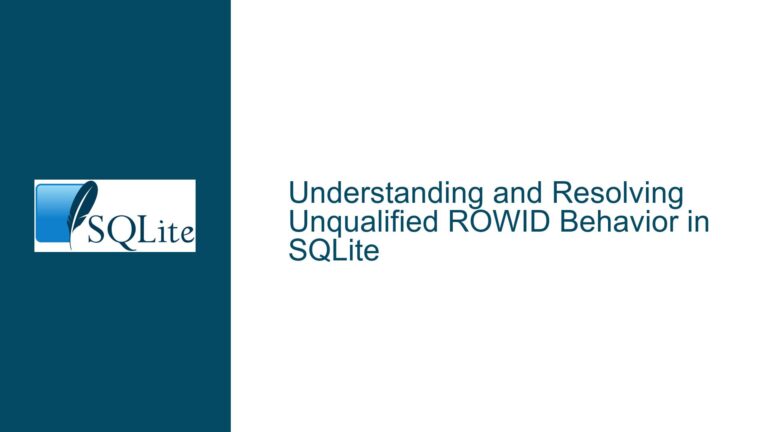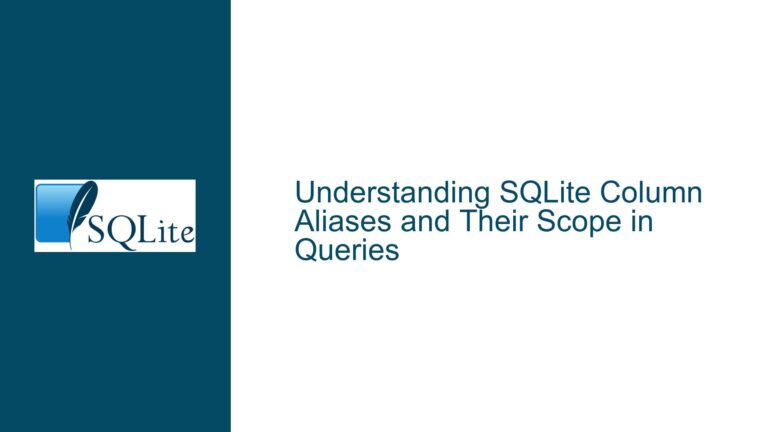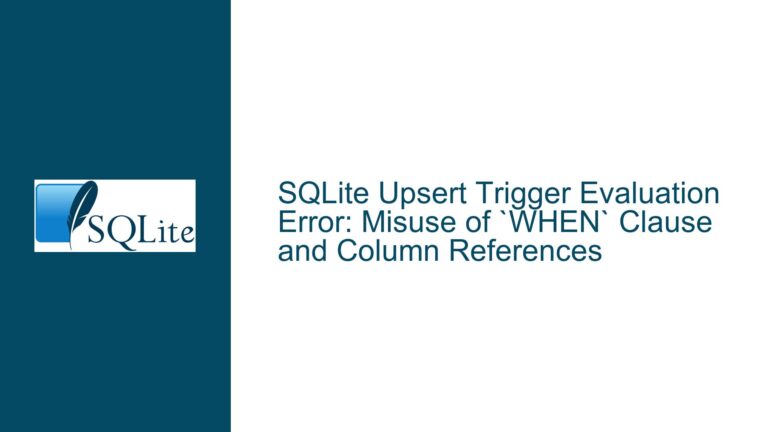Inconsistent Query Results Due to UNION Type Affinity in SQLite Views
Issue Overview: Mixed Column Affinities in UNION Views Causing Unexpected Query Outcomes
When constructing SQLite views that combine multiple SELECT statements via UNION or UNION ALL, inconsistencies in column affinities across the component queries can lead to unpredictable query results. This occurs because SQLite does not enforce uniform type affinities for compound queries, allowing the database engine to resolve ambiguities in ways that may not align with developer expectations.
Consider a scenario where a view is created using UNION with columns of differing affinities (e.g., BLOB in one arm and INTEGER in another). Subsequent queries against this view may produce divergent results depending on the context in which the view is used, such as whether a constant or a subquery is employed in a conditional expression. For example:
CREATE VIEW v0(c0) AS
SELECT CAST(NULL AS BLOB) FROM rt0
UNION
SELECT 1 FROM rt0; -- Mixed affinities: BLOB and INTEGER
Queries filtering results using expressions involving v0.c0 might yield empty results or return rows inconsistently:
-- Returns empty (affinity resolves to INTEGER)
SELECT v0.c0 FROM v0 WHERE ((v0.c0) <> (CAST(v0.c0 AS TEXT))) % 2;
-- Returns 1 (affinity resolves to BLOB)
SELECT v0.c0 FROM v0 WHERE ((v0.c0) <> (CAST(v0.c0 AS TEXT))) % (SELECT 2);
The discrepancy arises because SQLite dynamically resolves the column affinity of v0.c0 based on the query’s structure. When a subquery is present, the affinity resolution process may favor one arm of the UNION over the other, altering how values are compared or coerced during evaluation.
Possible Causes: Ambiguous Affinity Resolution in Compound Queries
1. Type Affinity Heterogeneity in UNION Components
SQLite assigns a type affinity to each column in a SELECT statement. When UNION or UNION ALL combines queries with differing affinities for the same column, the resulting compound query’s affinity is not standardized. Instead, SQLite permits the engine to select an affinity from the available options, as documented in SQLite’s type affinity rules for compound queries.
For instance, in the view v0, the first arm of the UNION defines c0 with BLOB affinity via CAST(NULL AS BLOB), while the second arm implicitly assigns INTEGER affinity to c0 through the literal 1. The view’s c0 column thus has no fixed affinity, allowing SQLite to choose either BLOB or INTEGER during query execution.
2. Context-Dependent Affinity Selection
The affinity chosen for a column in a compound query can vary depending on the context in which the column is used. For example:
- Constants vs. Subqueries: When a query includes a constant (e.g.,
% 2), SQLite may resolve the column affinity toINTEGER, as constants are typically treated as numeric. Conversely, subqueries (e.g.,% (SELECT 2)) may alter the optimizer’s affinity selection logic, potentially favoringBLOBif other factors (e.g., storage classes) influence the resolution. - Expression Evaluation Order: The presence of type-dependent operations (e.g.,
CAST,COLLATE) in theWHEREclause can force a specific affinity during expression evaluation.
3. Implicit Type Conversion and Comparison Semantics
SQLite performs implicit type conversions when comparing values of different storage classes. However, these conversions are influenced by the column’s affinity:
- A column with
INTEGERaffinity will convert values to integers when possible. - A column with
BLOBaffinity preserves the original storage class of values, deferring conversion until necessary.
For the expression (v0.c0) <> (CAST(v0.c0 AS TEXT)), the result depends on how v0.c0 is coerced:
- If
v0.c0hasINTEGERaffinity,CAST(v0.c0 AS TEXT)converts the value to a string (e.g.,1becomes'1'). The comparison1 <> '1'evaluates to0(false) because SQLite converts'1'to an integer. - If
v0.c0hasBLOBaffinity,CAST(v0.c0 AS TEXT)may produce different results depending on the original storage class. For instance, aBLOB-affinity column storing an integer1(as anINTEGERstorage class) would convert to'1'as text, but the comparison logic differs due to affinity rules.
Troubleshooting Steps, Solutions & Fixes: Ensuring Consistent Affinity and Predictable Query Behavior
1. Explicitly Standardize Affinities in Compound Queries
To eliminate ambiguity, ensure all arms of a UNION or UNION ALL query explicitly cast columns to the same affinity. This overrides SQLite’s automatic resolution and guarantees consistent behavior.
Example Fix:
CREATE VIEW v0(c0) AS
SELECT CAST(NULL AS BLOB) FROM rt0
UNION
SELECT CAST(1 AS BLOB) FROM rt0; -- Force BLOB affinity in both arms
By standardizing the affinity to BLOB, queries against v0.c0 will behave uniformly regardless of context.
2. Avoid Mixing Null and Non-Null Literals in UNIONs
NULL literals without explicit type annotations default to NULL storage class, which can interact unpredictably with non-NULL values in compound queries. Always pair NULL with explicit casts to match the affinity of other arms.
Example Fix:
CREATE VIEW v0(c0) AS
SELECT CAST(NULL AS BLOB) FROM rt0
UNION
SELECT CAST(1 AS BLOB) FROM rt0; -- Both arms use BLOB affinity
3. Use Deterministic Functions to Control Affinity
Incorporate SQLite’s deterministic functions (e.g., CAST, HEX) to enforce affinity before combining queries with UNION.
Example:
CREATE VIEW v0(c0) AS
SELECT CAST(col_with_unknown_affinity AS BLOB) FROM table1
UNION
SELECT CAST(another_col AS BLOB) FROM table2;
4. Leverage Subqueries or CTEs to Isolate Affinity Contexts
If standardizing affinities across a UNION is impractical, encapsulate the compound query within a subquery or common table expression (CTE) that explicitly defines the desired affinity.
Example:
WITH normalized_v0 AS (
SELECT CAST(c0 AS BLOB) AS c0 FROM v0
)
SELECT c0 FROM normalized_v0
WHERE ((c0) <> (CAST(c0 AS TEXT))) % 2;
5. Avoid UNION When Possible; Prefer UNION ALL with Explicit Filtering
UNION implicitly invokes DISTINCT, which can introduce unintended affinity resolution behaviors. Use UNION ALL to preserve all rows and pair it with explicit WHERE clauses or application-layer deduplication.
Example:
CREATE VIEW v0(c0) AS
SELECT CAST(NULL AS BLOB) FROM rt0
UNION ALL
SELECT 1 FROM rt0; -- Retains all rows; affinity resolution still ambiguous
6. Validate Affinity Resolution with EXPLAIN and PRAGMA Statements
Use SQLite’s EXPLAIN command and PRAGMA directives to inspect how affinities are resolved in specific queries.
Diagnostic Steps:
- Execute
EXPLAINon the problematic query to observe the bytecode generated for affinity handling.EXPLAIN SELECT v0.c0 FROM v0 WHERE ((v0.c0) <> (CAST(v0.c0 AS TEXT))) % 2; - Use
PRAGMA table_info(v0);to inspect the declared affinity of the view’s columns (note that views may not always report accurate affinities).
7. Test with Explicit Affinity Overrides in Queries
Temporarily override affinity in suspect queries using CAST or TEXT/BLOB literals to determine if affinity resolution is the root cause.
Example:
-- Force INTEGER affinity in WHERE clause
SELECT v0.c0 FROM v0 WHERE CAST((v0.c0 <> CAST(v0.c0 AS TEXT)) AS INTEGER) % 2;
-- Force BLOB affinity in WHERE clause
SELECT v0.c0 FROM v0 WHERE CAST((v0.c0 <> CAST(v0.c0 AS TEXT)) AS BLOB) % 2;
8. Monitor SQLite Version-Specific Behavior
Affinity resolution logic may evolve between SQLite versions. Test queries under both the latest trunk and stable releases, and consult the SQLite changelog for updates related to type handling.
Example:
- Version 3.45.0 introduced optimizations for
CASToperations inWHEREclauses. - Version 3.35.0 improved affinity resolution in compound queries.
9. Refactor Schema to Minimize Affinity Ambiguity
Redesign tables and views to avoid columns with inherently ambiguous affinities. For example, replace NULL literals with typed placeholders (e.g., CAST(NULL AS INTEGER)) if consistent affinity is critical.
Example Schema Fix:
-- Original table with potential affinity issues
CREATE TABLE tbl (a); -- No explicit affinity
-- Refactored table with explicit affinity
CREATE TABLE tbl (a BLOB); -- Forces BLOB affinity for all inserts
10. Educate Teams on SQLite’s Type Affinity Nuances
Developers and DBAs working with SQLite must understand that:
- Affinity is a column-level property, not a value-level one.
UNIONandUNION ALLpermit affinity mixing, which can lead to subtle bugs.- Testing under different query contexts (constants vs. subqueries) is essential for reliability.
By adopting these practices, teams can preempt affinity-related issues and ensure consistent query results across SQLite deployments.






